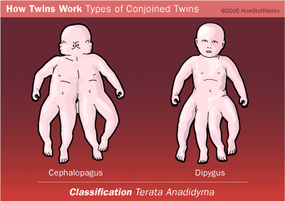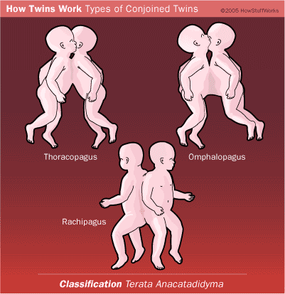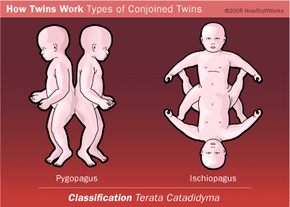Various Types of Conjoined Twins
Conjoined twins are monozygotic twins who are joined at some region of their bodies. The many different types of conjoined twins are classified by the area where the attachment is located:
Terata Catadidyma refers to twins joined in the lower portion of their body, or they may appear to be two bodies on top and one body on the bottom.
Advertisement
- Pygopagus - back-to-back, joined at the rump (about 19 percent)
- Ischiopagus - joined sacrum to sacrum (about 6 percent)
- Dicephalus - one body with two separate heads
- Diprosopus - single body and head, but bearing two faces
Terata Anadidyma refers to twins with one single upper body with a double lower half or twins who are connected by a single body part.
- Cephalopagus - connected at the head (about two percent)
- Syncephalus - connected in the facial region
- Cephalothoracopagus - connected in the facial region and at the thorax
- Dipygus - one upper body with two lower bodies (including the abdomen, pelvis and legs)

Terata Anacatadidyma refers to twins who are joined somewhere along the midsection of the body.
- Thoracopagus - joined at the chest; may share a single heart or have some cardiac connection; some organs in the abdominal region may be malformed (about 40 percent)
- Omphalopagus - joined at the chest (about 33 percent)
- Rachipagus - back-to-back, joined along the spine above the sacrum

There are also other forms of conjoined twins. Parasitic twinning is when one conjoined twin is much smaller and perhaps not as fully formed or developed as the larger twin. In rare instances, this results in limbs located in bizarre areas of a twin's body. For example, what appears to be a singleton birth arrives with an arm joined at his back or an additional leg joined at the hip region. The Internet Movie Database reports that actor Andy Garcia was born with a conjoined parasitic twin. The small malformed twin was surgically removed shortly after birth.
Another even more rare form of parasitic conjoined twinning exists. Fetus in fetu is when a malformed twin is discovered inside the body of a host twin — a living child or adult. Although it would be difficult to know the exact rate of incidence (as there may be cases that go undiscovered for long periods of time), it is believed that fetus in fetu occurs once in every 500,000 live births. In "Fetus In Fetu: A Case Report," Phatak, Kolwadkar and Phatak state: "Masses containing bones, cartilage, teeth, central nervous system tissue, fat and muscle may be found in the abdomen of newborns and children termed `Teratomas'. They are defined as fetus in fetu if there is a recognized trunk and limbs." [ref]
How and why conjoined twins are formed isn't definitively agreed upon. The main theory proposes that it happens when a fertilized egg that is going to split into a monozygotic set of twins doesn't fully separate. This is principally a matter of timing. As we discussed earlier, the sooner the split occurs, the more independent the MZ twins will be in relation to having separate or shared chorion, amnion and placenta. With conjoined twins, it is believed that the separation takes place very late (somewhere around day 12 or thereafter), so that it is never fully complete. Thereby leaving the twins physically connected to each other.
Conjoined twins happen very rarely and the survival rate is quite low. While they happen about one time in every 40,000 births, they make up only one in every 200,000 live births. Research indicates that about 40 to 60 percent of conjoined twins are stillborn (deceased at birth). And, another 35 percent remain alive for only one day after birth. Surviving twins are more often female than male. Even though more male pairs are conceived, the females lead the males 3:1 in making it to a live birth. There are probably less than 50 sets of non-separated conjoined twins living in the world today.
